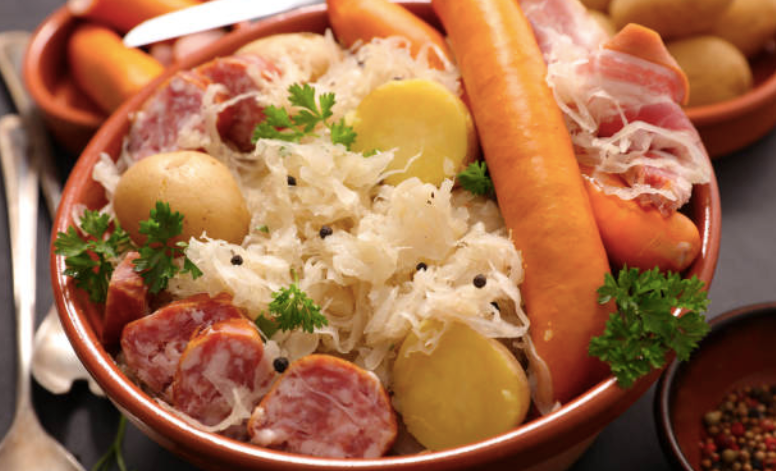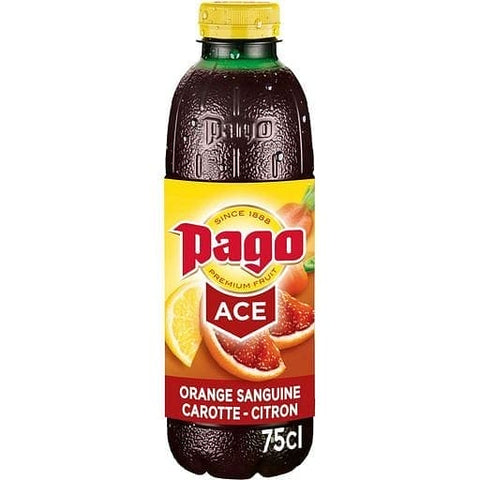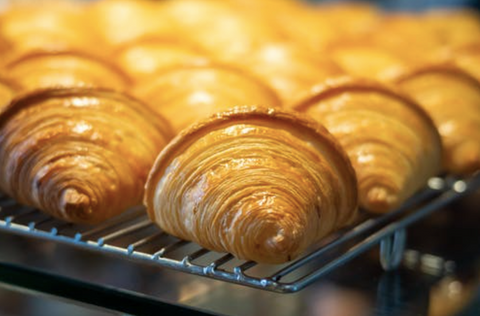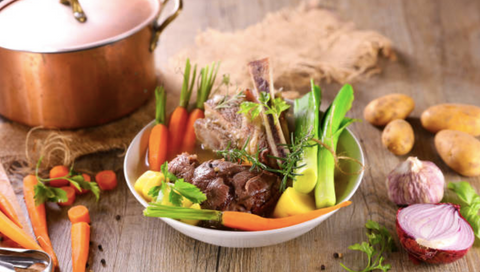Choucroute is a dish of Sauerkraut that is served with various smoked and cooked meats. It originated in Germany, but Alsace and other parts of France claim this dish as their own. It's not unusual to see Choucroute garnie on restaurant menus in France. The French pronunciation is "shoo-kroot," and the word is German for "sauerkraut."
The traditional version of Choucroute garnie includes several kinds of smoked or cured pork, including ham hocks, knuckles, fresh sausages, smoked sausages, bacon, and sometimes even tongue. The French usually add corned beef along with pork products. But some versions include goose or duck instead of pork or pork.
Most commercial brands of Sauerkraut found in supermarkets are completely drained before canning and are ready to use without any further preparation. If you buy bulk Sauerkraut from a deli or grocery store produce section, you will want to drain the Sauerkraut well before using it in this recipe.

Origin of Choucroute
Choucroute is the French word for Sauerkraut, a side dish made by fermenting cabbage and other vegetables. The term refers both to the dish and to an earthenware casserole in which it is cooked. A traditional Alsatian dish, Choucroute is eaten throughout France, especially during Christmas.
- Alsace is a region on the border of France and Germany fought over and controlled by both countries at various times in its history. Sauerkraut was introduced to Alsace by Germanic tribes, but it became part of French cuisine after Alsace became a full province of France in the late 1800s.
Meaning of Choucroute
The name Choucroute comes from the German word for Sauerkraut, "Sauerkraut." The name, in turn, derives from "Sauer," meaning sour or acid, and "Kraut," meaning cabbage or greens.
Choucroute garnie:
A dish of meats and sausages, including bacon, ham hock, and knuckle of pork, served with Sauerkraut and potatoes.
Choucroute is a famous dish in Alsace, in north-eastern France. It's a kind of Sauerkraut made with white wine and juniper berries, which are added slices of pork, smoked streaky bacon, and various types of sausage. It is usually served with boiled potatoes.
- Alsatian stews (Choucroute) are among the most popular dishes in France's eastern regions.
- The main ingredient is fermented cabbage (Sauerkraut) mixed with white wine and juniper berries, then cooked with various meats such as pork chops or belly, smoked bacon lardons (pork fat), Vienna sausages, and blood sausages. Choucroute is often served with boiled potatoes.
Difference between Sauerkraut and Choucroute
There are many different types of Sauerkraut, but only one type of Sauerkraut is traditionally used in Choucroute. The difference between the two is that all Choucroute is Sauerkraut, but not all Sauerkraut is Choucroute.
- Sauerkraut, simply put, is fermented cabbage. It can be made from green or red cabbage; it can be fermented with various spices (juniper berries and caraway seeds being the most traditional); it can be cooked or eaten straight out of the jar. It's as versatile as it is easy to make, and while there are many different variations on the theme, they're all still just Sauerkraut.
- Choucroute, on the other hand, is a dish made with specific ingredients: specifically, the Alsatian variety of Sauerkraut and special cuts of pork that aren't usually used outside this dish (namely hocks and rinds). This version of Sauerkraut is made by layering salted shredded cabbage with juniper berries and caraway seeds in a crock or barrel and letting it sit for a few weeks to ferment.
- Sauerkraut is fermented cabbage. Choucroute is French for "sauerkraut."
The two words refer to the same thing but are slightly different nuanced.
- "Sauerkraut" is the German word for this type of dish, and it usually refers to any Sauerkraut, whether it's served with hot dogs or served as a traditional dish.
- "Choucroute," on the other hand, specifically refers to a traditional French preparation of sauerkrout, which involves simmering it with meats like pork belly and sausage — although, in English, we often use the German word "sauerkraut" to refer to this kind of dish as well.
At its most basic level, Sauerkraut is simply cabbage that's been salted and allowed to ferment — but in culinary usage, the term refers specifically to a German style of fermented cabbage. The Germans have been eating Sauerkraut since at least the 14th century. Over time, regional variations developed in different parts of Germany:
Best-canned Sauerkraut
The best-canned Sauerkraut is the one you make yourself! It's easy, and it's a great side dish that goes well with many different main dishes.
- This simple sauerkraut recipe uses fresh cabbage and is fermented in a jar. The flavor is slightly sour and salty, which comes from the fermentation process. If you like a sourer flavor, you can allow it to ferment longer before eating. The longer you let it ferment, the more beneficial bacteria present in each bite!
- The salt helps to draw out moisture from the cabbage leaves, making them soft and pliable for rolling into balls or wrapping around fillings such as meatballs or meatloaf mixture. You don't need any special equipment or ingredients - just some patience while waiting for those tasty bubbles to form!
The best-canned Sauerkraut we found is by a company called Kuhne. It's the only brand with a salty, vinegary flavor and lots of crunchy texture.
The second-best canned Sauerkraut we found is by our store. It has a nice vinegary taste, but it doesn't have as much crunch as the Kuhne brand.
Taste of Choucroute
Choucroute, or Sauerkraut, is a dish of fermented cabbage. This is the same process used to make kimchi in Korea; to ferment the red cabbage that accompanies many German dishes and make sour pickles.
Fermented foods are a huge thing right now, especially as they are often promoted as a beneficial source of probiotics.
Choucroute is a French term, but it's also eaten in Germany, known as Sauerkraut.
- Some people might say it tastes sour or salty - and it does have both qualities. I would say it has a distinctive taste - somewhere between fresh shredded white cabbage and pickled red cabbage.
- It's less sweet than pickled red cabbage but more mellow than raw white cabbage - and with a tangy flavor from the fermentation process.
Other dishes that goes well with Choucroute
Choucroute is a typical French dish, especially in Alsace. It's made of Sauerkraut (finely sliced white cabbage that various lactic acid bacteria have fermented).
As Choucroute is usually served with the following main dishes, I'll tell you what goes well with them:
- Charcuterie: dried or smoked meats
- Pork knuckle, ham hock, and other cuts of pork
- Fresh or boiled sausage (such as bratwurst)
- Gravy, sauces, and mustards
- Creamy mashed potatoes, boiled potatoes, or potato salad.
- Rye bread (or another type of dark bread)
- Cheese
And here are some other side dishes that go well with Choucroute: pickled cucumbers, onions in vinegar, roasted onions, and applesauce.
How to eat Choucroute?
Typically, Choucroute garnie is served with a large alongside a beer stein. To begin, take a small amount of Choucroute and Sauerkraut and place it on your plate. Then, choose one of the meats to add to your plate. To eat the Choucroute garnie, use the fork to pierce the sausage and cut it into bite-sized pieces. The other meats are typically eaten by hand. Begin by placing the meat in your fingers and using your teeth to pull off bite-sized pieces of meat.
To make this dish at home, you need to find a source for authentic Alsatian Sauerkraut. If you cannot obtain Alsatian Sauerkraut, try substituting it with regular Sauerkraut.
La Choucroute which is served traditionally
Traditionally, there are three different ways to prepare a Choucroute.
- The first calls for the addition of goose or duck fat and goose or duck sausage
- The second uses Alsatian wines along with simmering stock
- And the third calls for everything to be cooked in Riesling wine
Today, though, most chefs use a combination of fats and wines to prepare the dish.
The preparation and serving of Choucroute vary throughout Alsace. Some restaurants serve Choucroute garnie, made with sausages, bacon, and ham on top of the Sauerkraut. Classic Choucroute garnie includes frankfurters, ham, and smoked pork chops. Other variations may include roasted pork knuckle or goose legs.
Some of the most well-known contemporary dishes prepared with Sauerkraut include corned beef and cabbage, Reuben sandwiches, hot dogs and sausages, kielbasa, and pierogi.
Sauerkraut has also been linked to several health benefits, including improved digestion.
Can we freeze a traditional Choucroute?
The answer is yes, but;
Freezing Choucroute will change both its texture and its taste. The freezing process destroys some lactic acid bacteria responsible for fermenting the cabbage. When you thaw the Choucroute, these bacteria regrow, altering the dish's flavor and making it sourer than before.
If you're looking for the best possible result so freezing Choucroute is not recommended Sausages for Choucroute
The Choucroute is a dish of the Alsace region in France, made with Sauerkraut and various meats, including smoked pork chops and sausages.
The most common sausages are:
- Knackwurst: Made from lean pork and beef, coarsely chopped; seasoned with salt, pepper, garlic, and other spices (not always); stuffed into a casing of natural pork intestine.
- Mettwurst: A traditional sausage of emulsified ground beef and pork shoulder, seasoned with salt, white pepper, and marjoram.
- Bockwurst: A sausage made of finely minced veal and pork seasoned with salt, white pepper, and paprika. Parsley, chives, or leeks are often added to Bockwurst as well. It is often served with mustard or béchamel sauce.
Traditional Choucroute is good for you
Choucroute is a speciality of Alsace. It consists of finely shredded Savoy cabbage, soaked in brine and seasoned with juniper berries and caraway seeds. It's then cooked slowly with potatoes, onions, sausages, and bacon or ham hock.
- Choucroute is a good source of fibres and vitamins C, K and B6. Because red meat is an important part of the dish (and the only way to cook it), Choucroute is rich in iron, zinc, and selenium.
- But it also contains a lot of sodium, so it should be eaten only occasionally if you have high blood pressure or kidney problems.
However, Choucroute has some additional health benefits as well. The fermentation process that produces Sauerkraut increases the number of probiotics (lactic acid bacteria) which aid digestion, boost our immunity to infection, and may help prevent cancer growth by neutralizing carcinogenic compounds in our digestive tract.
Wines that goes well with traditional Choucroute
Fortunately, there are lots of good pairings for Sauerkraut. The best wines for Choucroute, or any dish with lots of acidity and salt, tend to be the same ones that go well with pizza and other tomato-based dishes.
- Choucroute is traditionally made with white wine instead of beer, which softens the acidity of the kraut — a dry Riesling is classic. But if you don't like sweet wines, try something off-dry like Pinot Gris or a lightly oaked Chardonnay.
- The smokiness of the pork also makes it a good match for Beaujolais and other light reds like Pinot Noir or Gamay.
If you're looking for a sparkling wine pairing for Choucroute garni, Blanc de Blancs Champagne or Cremant d'Alsace would be great choices.
Popularity of traditional Choucroute in UK
The popularity of Choucroute in the UK has led to the introduction of ready-to-eat versions. The most obvious is a jarred version, precisely the same as you would make at home, but just bought ready to heat and eat. Assuming they are kept refrigerated, the cooking time on these is usually around 10 minutes.
Some manufacturers also sell a more heavily spiced version. It usually features extra wine (brandy), additional spices, and sometimes bacon. These take longer to cook (usually about 20 minutes).
This type is best served hot and goes especially well with pork dishes that have been marinated in wine or brandy.




